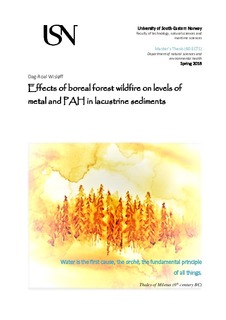Effects of boreal forest wildfire on levels of metal and PAH in lacustrine sediments
Master thesis
Published version
Permanent lenke
http://hdl.handle.net/11250/2577624Utgivelsesdato
2018Metadata
Vis full innførselSamlinger
Sammendrag
Entire catchments rich in acidic peatland, ponds, streams and lakes burned during a large boreal forest wildfire in Mykland (South-Eastern Norway) in 2008. Wildfire liberates accumulated metals, while incomplete combustion of organic matter generates PAHs. As post-wildfire runoff and erosion rates increase, migration of metals and PAHs from terrestrial to aquatic systems is intensified. If undisturbed, sediments are reliable environmental archives that document deposition history and provide information on particle-bound substances such as metals and PAHs.
By measuring concentration levels in surface / sub-surface sediments two years after the fire, this study seeks to explore lacustrine sediments in eight lakes as recipient depots of metals and PAHs mobilized, produced and redistributed during combustion and ensuing processes of boreal forest wildfire. In present study, elevated levels of metals and PAHs in surface sediments are not traceable compared to sub-surface sediments. The results demonstrate a decline in PAH levels, as well as for several metals. Metal concentrations depict a more complex pattern than the marked PAH decline. The results do however reflect regional trends of reduced atmospheric deposition of metals and PAHs during the decade preceding the fire. Nonetheless, surface sediments are polluted with several PAHHMW (i.e. PYR, BaA CHR, BbjF, BkF, BghiP, IcdP, DBa3A), HgLOI and Pb in six or more lakes. Half of the lakes are polluted with Zn, Cd, Hg, ACNLE and FLU. In addition to reduced input of LRTAP in the area, several mechanisms and processes, like mixing of lake bed sediments thru bioturbation; post-depositional degradation and removal thru biotics’ ingestion; re-mobilization thru resuspension of sediments and diffusion across the sediment-water interface, among others, may co-account to the post-fire decline of metals and PAHs. To conclude, surface sediments share no signal of any metal / PAH contamination in response to wildfire, strong enough to counter the general decline documented for these substances in the region.
As climate moves towards more “wildfire weather” with intensified drought, heavier thunderstorms and more wind, fire is expected to shift from a natural part of an evolved ecosystem, to more frequent and severe wildfires, most often ignited by reckless act of man. Intensified post-fire rainfall events increase the mobility of released contaminants that has accumulated in forest soil and flora, posing a considerable hazard to catchment ecosystems and waterbodies. In an ecotoxicological perspective, lacustrine sediments contaminated with metals and PAHs present a threat to water quality, aquatic ecosystems and biodiversity due to the high toxicity, environmental persistence and bioavailability of these substances. Environmental contaminants released from aquatic sediments can be absorbed by flora and fauna if on a bioaccessible state, and thru bioaccumulation and / or biomagnification, ultimately end up in humans. Forest catchments with low levels of contaminants in soil and waterbodies are literally vital to life. However, the supply of sufficient water quality and quantity is seriously challenged at global level by the impacts of natural and anthropogenic activities, including wildfire.
